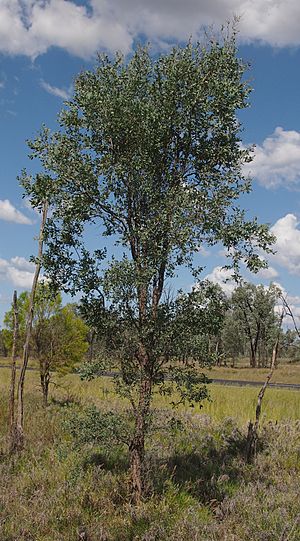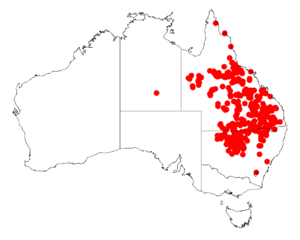Ironwood facts for kids
Quick facts for kids Ironwood |
|
|---|---|
 |
|
| Habit | |
| Scientific classification | |
| Genus: |
Acacia
|
| Species: |
excelsa
|
 |
|
| Occurrence data from AVH | |
The Ironwood tree, also known as Acacia excelsa, is a special type of tree found only in certain inland areas of north-eastern Australia. People also call it rosewood, bunkerman, and doodlallie. In the Gamilaraay language, it has names like dhan, gayan, or gan.
Contents
What Does the Ironwood Tree Look Like?
The Ironwood tree can grow as a large shrub or a tall tree. It usually reaches a height of about 3 to 15 meters (10 to 49 feet), but some can grow as tall as 20 meters (65 feet)! It often has branches that spread out or even droop a little.
Its bark is hard, gray, and has cracks in it. The smaller branches are smooth, without any hairs. The wood of this tree has a sweet smell, a bit like cut violets.
Like many Acacia trees, the Ironwood doesn't have regular leaves. Instead, it has special flattened stems called phyllodes. These phyllodes are smooth and stay green all year. They are usually straight or slightly curved, and look like narrow oval or oblong shapes. They are typically 2 to 7 centimeters (0.8 to 2.8 inches) long and 3 to 22 millimeters (0.1 to 0.9 inches) wide. Each phyllode has three to seven clear lines running along it.
Flowers and Seed Pods
The Ironwood tree blooms between March and June. Its flowers grow in small, round clusters, usually found where the leaves meet the stem. These flower-heads are about 4 to 8 millimeters (0.16 to 0.31 inches) across and have 20 to 35 bright yellow flowers.
After the flowers, the tree grows flat, straight seed pods. These pods are a bit brittle and look like they are squeezed between each seed. They are smooth, 4 to 11 centimeters (1.6 to 4.3 inches) long, and 6 to 12 millimeters (0.24 to 0.47 inches) wide. They often have a fine white powdery coating on them.
How the Ironwood Tree Got Its Name
The Ironwood tree was first officially described by a botanist named George Bentham in 1848. This happened during Thomas Mitchell's trip into the middle of Australia.
Later, in 1987, another botanist, Leslie Pedley, gave it a different scientific name, Racosperma excelsum. But in 2006, it was moved back to the Acacia group. The word "excelsa" in its scientific name means "tall," which makes sense because this tree can grow very high!
Where Ironwood Trees Grow
Ironwood trees are found in many places across inland southern Queensland and into northern and central New South Wales. In New South Wales, you can find them as far south as Condobolin and as far east as Warialda.
They usually grow in sandy, loamy soils. You'll often see them in open woodlands or grassy areas called savannahs.
Uses of the Ironwood Tree
The bark of the Ironwood tree, like other Acacia species, contains natural substances called tannins. These tannins can be used for different purposes. For example, they can be used in some traditional medicines to help with problems like diarrhoea or dysentery. When used on the outside of the body, they might help with wounds or some eye issues.
The tree also produces a sticky substance called gum from its stems. This gum can also be used in traditional remedies for similar health issues.
The wood from the Ironwood tree is very strong, tough, and flexible. It has a fine grain, which means it's good for making things like special furniture or parts of musical instruments. Long ago, Indigenous Australian people used this wood to make tools like boomerangs and spearthrowers.

